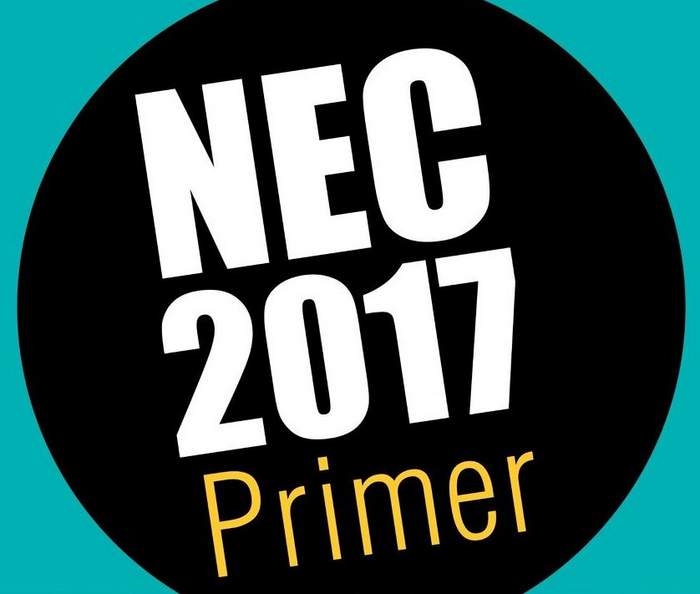
Jan. 1, 2019, is almost upon us, which means the National Electric Code (NEC) 2017 is almost in effect. Not all jurisdictions will be up to speed (hell, some aren’t even up on NEC 2014 yet), but around 24 states will require compliance immediately. We asked a variety of manufacturers about their NEC 2017-ready products, how they work and any advice they have for solar installers to meet the new code.
This section is from our Nov/Dec issue of Solar Builder magazine. Subscribe for free right here.
Code to know
690.12 Rapid Shutdown of PV Systems on Buildings
PV system circuits installed on or in buildings shall include a rapid shutdown function to reduce shock hazard for emergency responders in accordance with 690.12(A) through (D).
(A) Controlled Conductors. Requirements for controlled conductors shall apply to PV circuits supplied by the PV system.
(B) Controlled Limits. The use of the term, array boundary, in this section is defined as 305 mm (1 ft) from the array in all directions. Controlled conductors outside the array boundary shall comply with 690.12(B)(1) and inside the array boundary shall comply with 690.12(B)(2).
1. Outside the Array Boundary. Controlled conductors located outside the boundary or more than 1 m (3 ft) from the point of entry inside a building shall be limited to not more than 30 volts within 30 seconds of rapid shutdown initiation. Voltage shall be measured between any two conductors and between any conductor and ground.
2. Inside the Array Boundary. The PV system shall comply with one of the following:
(1) The PV array shall be listed or field labeled as a rapid shutdown PV array. Such a PV array shall be installed and used in accordance with the instructions included with the rapid shutdown PV array listing and labeling or field labeling.
(2) Controlled conductors located inside the boundary or not more than 1 m (3 ft) from the point of penetration of the surface of the building shall be limited to not more than 80 volts within 30 seconds of rapid shutdown initiation. Voltage shall be measured between any two conductors and between any conductor and ground.
Know your signs
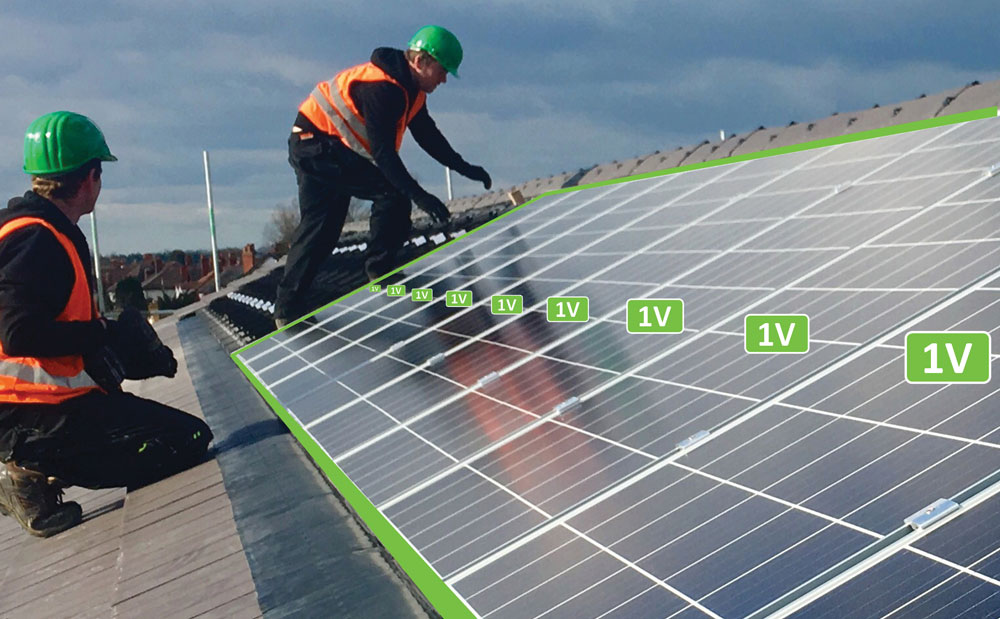
SolarEdge’s SafeDC technology is embedded in its DC optimized solution and as such meets NEC 2017 without any additional components. The existing PV system AC disconnect is used as the initiator. Whenever the inverter or grid is turned off (i.e. AC power), then the DC voltage and current fall below the NEC 2017 thresholds within 30 seconds — each power optimizer is responsible for lowering its output voltage to 1 volt during rapid shutdown activation. This happens both in and outside the array boundary.
“New signs are required to inform emergency responders of the equipment meeting NEC 2017. NEC 2017 requires that equipment used as rapid shutdown devices be listed for rapid shutdown and evaluated according to stringent standards. Installers should check to ensure all equipment is properly listed. For example, inverters and combiners that are used inside or outside the array boundary as rapid shutdown devices must be listed for rapid shutdown in the event that they are used for that purpose,” says Lior Handelsman, founder, VP of marketing for SolarEdge.
 Don’t skimp on labels
Don’t skimp on labels
HellermannTyton offers a line of NEC 2017 code compliant labels that have been tested to actual real-world conditions for over seven years and through accelerated aging tests, which show the labels will survive decades of exposure [see example of one that did not on the right]. Because of the extensive testing of these solar-compliant labels, HellermannTyton offers a seven-year warranty on all adhesive labels that include the HT check mark and a 25-year warranty on any aluminum labels.
“Many municipalities are very concerned about label life. In this age of OSHA and ANSI compliance, there is increased liability on installers and inspection services. If a label only remains visible for a few years, and if someone gets injured or killed in the process of interacting with the equipment, there can be substantial fines or costly litigation that can affect on-going business,” says Todd Fries, product category manager – identification for HellermannTyton.
Watch for SunSpec certification
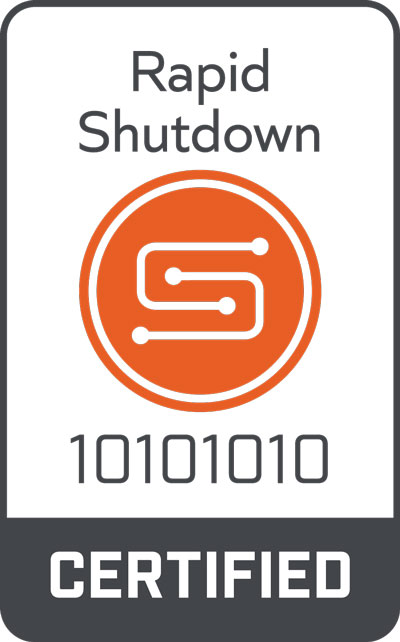
If you’re unfamiliar with the SunSpec Alliance, it’s time you became familiar. This trade alliance of more than 100 solar and storage stakeholders has been working on information standards for plug-and-play PV system interoperability, but its communication solution for meeting module-level power control and safety (rapid shutdown) with any panel and inverter combination might be its crowning achievement. Look for the logo to the left to find products certified to the SunSpec RSD Specification. Here’s a list of early adopter companies involved in the collaboration and rollout.
• ABB
• Adesto Technologies
• Canadian Solar
• Celestica Inc.
• Chint Power Systems –
North America
• Delta Products
• Enphase Energy
• ER Solar
• Fronius International
• Ginlong-Solis
• Hansol Technics Co.
• HiQ Solar
• Itek Energy
• Ingeteam
• JA Solar
• LERRI Solar Technology
• Maxim Integrated
• Mersen Electrical Power
• Midnite Solar
• Neo Solar Power
• Omron Global
• OutBack Power
• Phoenix Contact
• SMA
• Samil Power
• Seraphim Solar USA
• Semitech Semiconductor
• Silfab Solar
• Solartec
• ST Micro
• Sungrow
• SunPower
• Sunrun
• Sunpreme
• Suntech Power
• Talesun Tesla
• Texas Instruments
• Tigo Energy
• UL LLC
• Yaskawa Solectrica
• Yingli Solar

This is a diagram of how the SunSpec Communication signal for module-level rapid shutdown works.
 Compliance doesn’t mean cost
Compliance doesn’t mean cost
“It is important to know what the actual requirement is and then getting to code compliance in the simplest, most cost-effective way to not put extra financial burden on the customer. We believe that industry standards and innovation will drive down cost and allow customer choice,” says Richard Baldinger, head of marketing for Fronius.
The Fronius Symo Advanced three-phase inverter combines the benefits of the Fronius Symo with the convenience of an open industry standard. Featuring 10 models ranging from 10 kW to 24 kW, the Fronius Symo Advanced meets NEC 2017 compliance in conjunction with the Tigo TS4-F cover via the integrated Power Line Communication (PLC) transmitter that uses the SunSpec communication signal for rapid shutdown. This eliminates the need for any additional communication hardware and provides the most cost-effective option for code compliance.
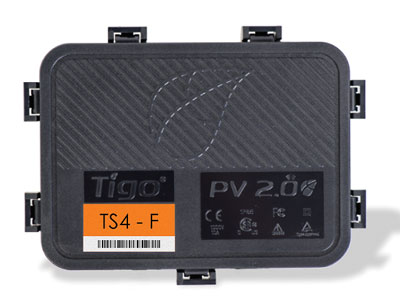 Tigo Energy’s TS4-F (Fire Safety) is a UL-certified multivendor rapid shutdown solution for commercial PV systems that complies with NEC 2017. The TS4-R-F is a simple add-on that retrofits a regular standard solar module with a module-level rapid shutdown device and is compatible with the power line-based SunSpec communication signal for rapid shutdown. Using the existing DC wires between the inverter and module-level electronics as a communication channel significantly reduces installation time.
Tigo Energy’s TS4-F (Fire Safety) is a UL-certified multivendor rapid shutdown solution for commercial PV systems that complies with NEC 2017. The TS4-R-F is a simple add-on that retrofits a regular standard solar module with a module-level rapid shutdown device and is compatible with the power line-based SunSpec communication signal for rapid shutdown. Using the existing DC wires between the inverter and module-level electronics as a communication channel significantly reduces installation time.
 Midnite Solar’s MNLSOB line, in both 600-volt and 1,000-volt models, utilize one transmitter and multiple receivers per system. This product can be used for string or module-level shutdown by using one receiver per string or one per module. They plug directly into the MC4 connectors on your module and, because the MNLSOB transmitter induces a PLC signal into the PV Positive line, there is no additional or new wiring to be done between the transmitter and the receivers. Midnite Solar will be introducing a new SunSpec-compliant MNLSOB by January.
Midnite Solar’s MNLSOB line, in both 600-volt and 1,000-volt models, utilize one transmitter and multiple receivers per system. This product can be used for string or module-level shutdown by using one receiver per string or one per module. They plug directly into the MC4 connectors on your module and, because the MNLSOB transmitter induces a PLC signal into the PV Positive line, there is no additional or new wiring to be done between the transmitter and the receivers. Midnite Solar will be introducing a new SunSpec-compliant MNLSOB by January.
Make no compromises
“There are no additional design requirements to implement shutdown functionality. A designer can build a project for maximum energy harvest, optimal ROI, or with any other goal in mind and simply choose the most cost-effective MLPE to address his or her needs. The shutdown functionality is built into these solutions and does not impact other project considerations. Installers should also be aware of the upcoming release of UL Standard 3741 as another way to comply with NEC 201 690.12 without requiring module-level shutdown by using equipment listed as ‘PV Hazard Control Arrays,’” says Brad Dore, director of marketing for SMA America.
SMA’s Sunny Tripower CORE1 meets the shutdown requirements of NEC 690.12 when paired with a TS4-R-F module-level device. The inverter and MLPE retrofit unit operate on the new SunSpec Power Line Communication (PLC) signal for module-level rapid shutdown. This solution is the most cost-effective way to achieve module-level shutdown. The solution operates on a simple “stay alive” signal broadcast from the inverter over the existing DC wires. The TS4-R-F units will operate while AC power is present, and if AC power is cut via the AC disconnect, the MLPEs lose the “stay alive” signal and de-energize in accordance with code.
Streamline to ground
Section 690.43 states that “Exposed noncurrent-carrying metal parts of PV module frames, electrical equipment, and conductor enclosures of PV systems shall be grounded in accordance with 250.134 or 250.136(A), regardless of voltage.”

Brilliant Rack racking systems feature mounting connections with serrated bolts that ensure the most effective metal-to-metal contact for proper bonding connections. These connections are essential for dispersing any electrical charge, providing multiple pathways to soil in compliance with Section 250.92 B. This reduces the danger of equipment damage or human injury should the rack become electrically charged through equipment malfunction, human error or lightning strike. Independent testing has demonstrated Brilliant Rack systems are capable of dispersing higher currents through the system into soil, and that the serrated bolt and nut are likely to maintain this connection better over a long period of time than WEEB clips.

SunModo’s ground lug, self-bonding clamps and self-bonding rail splices meet the requirements found in NEC 2017. The basis of the self-bonding system is its patented stainless-steel floating bonding pin, which is designed to be captive in the mounting components and provides a bonding path from the PV panel frames to the rails and rail splices and finally to the ground lug. The Ground Lug is compliant with both UL 467 and the equipment grounding requirements 690.43. The self-bonding system is for use with PV modules that have a maximum series fuse rating of 30A.
Rooftop Adder Table removed
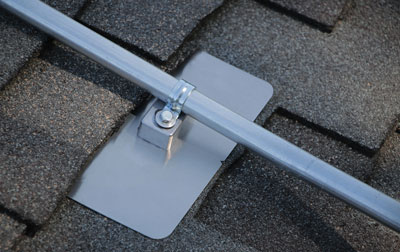
“The Rooftop Adder Table that has affected the ampacity calculations for conductors that are run at a specified distance above a rooftop has been deleted. This table generally hasn’t been well accepted by electrical personnel since its addition to the NEC several years ago. Because of the deletion, if raceways are kept at least 7/8 of an inch above the rooftop, there should no longer be a need for upsizing conductors and increasing costs,” says Randy Barnett, safety compliance professional for the NFPA.
Quick Mount PV has two NEC 2017-ready products in its classic conduit mount and conduit mount for tile. When used in conjunction with a standard off-the-shelf conduit hanger, the conduit is raised in excess of the minimum 7/8-in. off the roof surface, which is new in NEC 2017. These mounts are designed to lift electrical conduit off the roof to protect wiring from overheating. These mounts use Quick Mount’s proprietary waterproofing technology to seal the roof penetrations, and aluminum and stainless steel parts are used to secure the electrical conduit for the life of the system.
— Solar Builder magazine
[source: https://solarbuildermag.com/products/nec-2017-solar-installation-rapid-shutdown-primer/]

Leave a Reply
You must be logged in to post a comment.